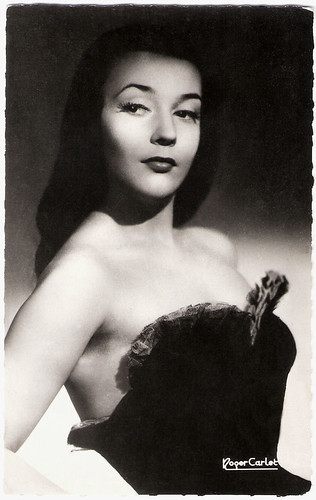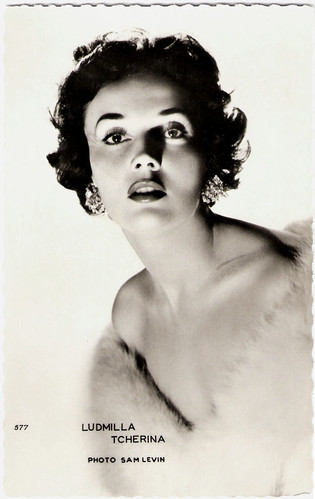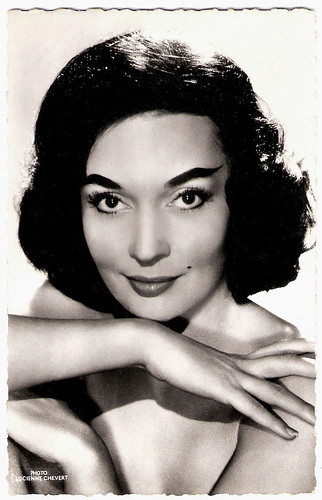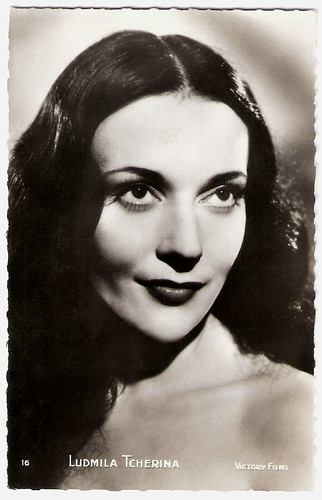
French postcard by Editions du Globe (EDUG), Paris, no. 116. Photo: Roger Carlet.

French postcard by Editions P.I., Paris, no. 577, offered by Les Carbones Korès. Photo: Sam Lévin.
Prima Ballerina
Ludmila or Ludmilla Tchérina was born as Monique Tchemerzine into Russian aristocracy in Paris, France, in 1924. She was the daughter of Circassian Prince Avenir Tchemerzine, a former general who had escaped from St. Petersburg, and Stéphane Finette, a Frenchwoman.
The family had little money, but Monique started ballet around the age of three, eventually studying with some of the greatest names in Paris - the former Maryinsky ballerina Olga Preobrajenska, and the former Bolshoi ballet master Ivan Clustine, the influential French teacher Gustave Ricaux.
Her first teacher, though, was Blanche D'Alessandri, who came from the strict Italian school and instilled technique with the help of taps on the body from a stick. This old-fashioned approach worked wonders.
After escaping with her mother to Marseilles at the start of the Second World War, she made her professional début at 15 and was a star dancer at the Opéra de Marseille at 16.
In 1943 she transferred to the Nouveaux Ballets de Monte Carlo where she was spotted by Serge Lifar, then director of the Paris Opéra Ballet. He invented her stage name, Ludmila Tchérina (used next to Ludmilla Tchérina), and choreographed Romeo and Juliet, to Tchaikovsky's Fantasy Overture, for himself and Tchérina, an extended pas de deux that was premiered at the Salle Pleyel in Paris in 1943.
In 1945 she was a principal dancer with the Ballet des Champs-Élysées and performed in Paris concerts with Edmond Audran, who became her husband in 1946. She created various roles in Lifar's ballets including: Mephisto Waltz in 1945, A la memoire d'un heros (In Memory of a Hero) in 1946 and in Le Martyre de Saint-Sebastian (The Martyrship of Saint Sebastian) in 1957.
She appeared often with the Paris Opera, the Bolshoi Ballet and the Kirov Ballet as a guest performer. Tchérina was 21 when she was offered her first film role in the French drama Un revenant/The Lover's Return (Christian-Jaque, 1946) starring Louis Jouvet and Gaby Morlay.
In 1948 she made her English-speaking film debut with the stylized fairy tale classic The Red Shoes (Michael Powell, Emeric Pressburger, 1948) featuring Moira Shearer and Marius Goring, but she did not understand what she was saying. She had to memorize her dialogue phonetically.

French postcard by Editions du Globe (EDUG), no. 621. Photo: Lucienne Chevert.

French postcard by Editions P.I., Paris, no. 16, offered by Les Carbones Korès. Photo: Victory Films.
Funeral March
Ludmila Tchérina won the French Cesar award for a short film version of Lifar’s ballet A La Memoire du Hero/In Memory of a Hero (Ray Ventura, 1951). In this film she portrayed Napoleon Bonaparte, dancing in travesty to the Funeral March of Beethoven's Eroica.
She went on to perform gloriously in The Tales of Hoffman (Michael Powell, Emeric Pressburger, 1951). Both of these films also featured her husband Edmond Audran. Shortly after the filming of The Tales of Hoffman, Audran was tragically killed in a road accident at age 33. The car accident left her shattered and the grief stricken Tchérina went into seclusion.
She was convinced to return to her art form in 1953 by her second husband Raymond Roi. He was a renowned French financier and industrialist, who remained her husband until her death in 2004.
Roi's wealth gave her the freedom to form her own experimental company which existed in 1958-1959 and appeared at the Théâtre Sarah-Bernhardt (now Théâtre de la Ville). For this, she commissioned Les Amants de Téruel, a dance theatre piece, devised by Raymond Rouleau and choreographed by Milko Sparemblek to a commissioned score by Mikis Theodorakis; and also Le Feu aux poudres (1958), which had a libretto by film director Jean Renoir and a choreography by Paul Goubé.
In 1960 she was the first Western dancer to appear at the Bolshoi Theatre and in 1970 she still enthralled audiences with her dance performance in Joan of Arc at the Stake.
Small German collector's card by Druckerei Hanns Uhrig, Frankfurt a.M.. Photo: NF. Still from Oh... Rosalinda!! (1955).
French postcard by Imp. De Marchi Frères, Marseille.
Breathing and Movement
The Tales of Hoffman had perked the eyes and ears of Hollywood, and Ludmila Tchérina made her American film début in Sign of the Pagan (Douglas Sirk, 1954), co-starring with Jeff Chandler and Jack Palance. In this film she performed a straight dramatic role along with an interpretative dance. This marked her first departure from classic ballet.
She also starred in the British Die Fledermaus adaptation Oh...Rosalinda!! (Michael Powell, Emeric Pressburger, 1955) with Anthony Quayle and Dennis Price, Luna de miel/Honeymoon (Michael Powell, 1959) with Anthony Steel, and the film version of Les amants de Teruel/The Lovers of Teruel (Raymond Rouleau, 1962).
She appeared less and less in films but regularly appeared in television shows. In the theatre she played Anna Karenina (1975), very dramatic in appearance and manner. On French television she starred in Salomé (1972), La Dame aux camélias (1974) and La Reine de Saba/The Queen of Sheeba (1975).
Ludmila Tchérina had a lifelong passion for painting and exhibited in many major galleries. In an exhibition at the Pompidou Center in Paris, she painted and danced in order to illustrate her concept of ‘total art’ in which all aspects are born of breathing and movement.
She also conceived and executed several monumental sculptures, including Europe à Coeur, chosen in 1991 by the EU to symbolize the union of Europe and now located at the European Parliament. In 1994 she created Europa Operanda, now installed at the French terminal of Eurotunnel.
In 1980 she was decorated Officier, Legion d'honneur in 1980. She authored two novels in the 1980s: L'amour au miroir (1983) and La femme a l'envers (1986).
Ludmila Tchérina died in 2004 after a long illness at her luxurious home in Paris.

French postcard by Editions du Globe, Paris, no. 290. Photo: Studio Harcourt.
Scene from Fandango (Emil E.Reinert, 1949) with Luis Mariano and Ludmilla Tchérina. Source: ximowb (YouTube).
Sources: Nadine Meisner (The Independent), Gary Brumburgh (IMDb), Wikipedia, and IMDb.
No comments:
Post a Comment